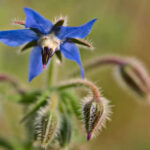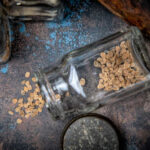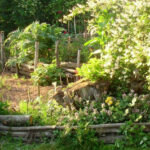If you want to add pops of green, waxy reds, and streaks of gold to your living space, look no further than Peperomia. These flowering plants are native to Central and South America and fit right into the domestic climate.
As tropical plants, they don’t need full sun or high heat to thrive. There are over 1000 species within the Peperomia genus with varying natural habitats. That means there’s a wide range of growing conditions depending on the variety you choose.
But that doesn’t mean these lovely plants aren’t easy to care for. We’ve dedicated this piece to discussing what peperomia plants prefer, and how you can emulate those conditions in your home.
Quick Care Guide
| Common Name | Peperomia, winged peperomia, watermelon peperomia, watermelon begonia, arid-land peperomia, hairy peperomia, etc. |
| Scientific Name | Peperomia spp. |
| Family | Piperaceae |
| Height & Spread | Species-dependent, up to 3 feet tall, and 4 feet wide |
| Light | Low to medium indirect light |
| Soil | Well-draining, species-dependent |
| Water | Water when completely dry |
| Pests & Diseases | Fungus gnats, spider mites, caterpillars, whiteflies, rot, leaf spot, |
All About The Peperomia Plant
Peperomia plants have many common names that refer to their particular species or variety. Many are known a the radiator plant, and are native to South and Central America, though there are some species native to Africa too. New species of Peperomia are identified on a regular basis. For now, the entire genus is composed of over 1000 species. Most are grown as indoor plants in North America.
Because they subsist in varying habitats, peperomia plants have different botanical structures. The genus includes 4 types: epiphytes, lithophytes, xerophytes, and geophytes. Some enjoy the humid jungle floor; others prefer the warmth and dryness of the desert. What is common among all species is their perennial shrub or vining growth pattern.
Another commonality involves the flowers, which are barely noticeable and bloom in long spikes. These die away, revealing small berries that shrivel and fall to the ground. Within the flesh of the berry is a single seed that has the ability to grow another peperomia. These are dust-like and may be difficult to obtain for growers at home.
There are a few edible species out there, adding a dash of peppery flavor to fresh salads and cocktails. Although not all are used in culinary settings, they’re largely non-toxic, making them great for homes where pets and children reign. They have been used in Peru as medicine for a long time too. And they will clean the air in your home.
Much like other houseplants, peperomia is easy to propagate and offers instruction to those who want to dip their toes in the propagation pool.
Peperomia Varieties
There are 4 types of peperomia plants. Different peperomia types refer to their habitat. Epiphytes grow on other plants, like trees, or bushes. Lithophytes grow in the crevices of rocks. Xerophytes grow happily in dry areas and are drought-tolerant. Finally, geophytes live and spread through the earth’s soil. Those growing on plants, among rocks, and in desert-like conditions have less substantial roots than those living in the soil. In the geophytic case, the roots are tuberous, and the foliage is succulent.
Peperomia alata, ‘Winged Peperomia’
A geophytic peperomia plant that spreads by rhizomes. “Wings” extend off long leaf stems. This peperomia plant develops tight, furry-looking green flower spikes. The medium to dark green leaves are oval to lanceolate. Grows in swamps and is a low groundcover.
Peperomia argyreia, Peperomia sandersii, ‘Watermelon Peperomia’, ‘Watermelon Begonia’
The Watermelon peperomia plant has watermelon-like striped leaves. At certain angles, they look like tiny watermelons attached to a vine. Watermelon peperomia is not related to either watermelons or begonias. Peperomia argyreia (watermelon peperomia) originates in South America.
Peperomia blanda, ‘Arid-Land Peperomia’, ‘Hairy Peperomia’, ‘Alaala Wai Nui’
Found in Hawaii, ‘ala’ala wai nui is an epiphytic bedding plant. It’s also found growing on damp rocks in most tropical regions of the world including Asia, Africa, Australasia, and the Americas. Deep green perennial often considered a creeping or low-lying. May have height up to 20-22″, but usually stays close to the ground.
Peperomia caperata, ‘Ripple Peperomia’, ‘Little Fantasy Peperomia’
Rippled, heart-shaped, thick leaves that are deeply textured with a bright green hue. Emerald ripple peperomia are somewhat-succulent evergreen perennials that mound, with red stems reaching up to 8″ in height. Native to Brazil, does well in moderate to low-light environments and produces fuzzy white peperomia flower stalks.
Peperomia nivalis
Averaging six inches in height, peperomia nivalis has tiny leaves which are fleshy and hatchet-6 inches in height, with tiny thick fleshy leaves that are hatchet-shaped. A common semi-succulent houseplant worldwide. Originating in Peru grows in a rounded mound. Understated lower stalks are nearly the same color as the leaves.
Peperomia obtusifolia, Peperomia clusiifolia ‘Baby Rubberplant’, ‘Baby Rubber Plant’, ‘Pepper Face’, ‘Blunt-Leaf Peperomia’, ‘Marble Peperomia’, ‘Green Peperomia’
Pepper faces, also called baby rubber plants, comes from Mexico, parts of the Caribbean, and Florida. Looks like a rubber plant, but this evergreen with leathery, cupped leaves is not related to the rubber plant. Some cultivars have different coloration than the standard deep green. Can have cream, grey, or gold streaking. Seldom gets larger than 1 foot tall or wide
Peperomia pellucida, ‘Pepper Elder’, ‘Shining Bush Plant’, ‘Man To Man’, ‘Silverbush’
A mustard-like aroma when the leaves are bruised. Often used in traditional herbal medicine. Clumping growth with succulent-like stalks, heart-shaped fleshy leaves, and shallow epiphytic roots. Native to the Americas and Asia. Used as a food plant, medicinally, and ornamentally in South and Central America.
Peperomia prostrata, ‘String of Turtles’
Another specimen great for hanging baskets, this vining plant has oval leaves that look like turtles. Needs indirect sunlight and high humidity.
Peperomia nitida, Peperomia serpens, Peperomia scandens ‘variegata’, ‘Cupid Peperomia’
Native to South America, this vining plant is great for hanging baskets, and looks much like a variegated philodendron with medium to bright green heart-shaped leaves and cream streaks.
Peperomia tetraphylla, ‘Acorn Peperomia’, ‘Four-Leaved Peperomia’
Epiphytic peperomia tetraphylla is native to Asia, Africa, New Zealand, Australia, and other Pacific Ocean island regions. Prefers moist, semi-tropical environments overall. Grows in clumps, covering tree branches or rocky outcroppings.
Peperomia polybotrya, Peperomia orba, Peperomia obtusifolia variegata, ‘Variegated Peperomia’ ‘Coin-leaf peperomia’, ‘Teardrop Peperomia’, ‘Raindrop plant’, Teardrop plant’
This plant has an upright normal growth pattern, fewer leaves than other varieties, and a slow growth rate. Tear drop-shaped leaves live happily in a small container. Does best in small spaces where direct light is accessible. Brighter light is better than indirect sunlight.
Peperomia albovittata, ‘White Bird of Paradise’, ‘Blanket Leaf Plant’
Similar to Peperomia argyreia with defined silvery stripes, this slow-growing epiphyte is native to Ecuador. Appreciates bright sunlight, and insufficient light will cause slower growth. Mounding to upright.
Peperomia angulata
Wonderful plants for hanging in bright, indirect light. Mildly variegated green and green-yellow leaves. Some of the most forgiving plants in this category.
Peperomia incana, ‘Felted peperomia’
Evergreen perennial with fuzzy or felted leaves. Makes peperomia care easy, and produces peperomia flowers in summer. Does best in bright indirect light, in a container with substantial drainage holes.
Peperomia wheeleri, ‘Wheeler’s Peperomia’
Found almost exclusively in Puerto Rico. Epiphytic, clinging to native rocks and humus. Considered endangered by the U.S. Department of the Interior, there have been steps taken to preserve specimens of Wheeler’s peperomia, both in Puerto Rico and elsewhere. Occasionally displayed as ornamental, but is rare outside of ideal growing conditions.
Peperomia rotundifolia, ‘Jade Necklace’
Vining plant native to rainforests of S. America. Similar to prostrata with vibrant foliage colors that are bright green-yellow. Peperomia light needs here are low and grow best in hanging containers and terrariums.
Peperomia ‘Rosso’, ‘Eden Rosso’
Very striking, even when compared to Peperomia argyreia. A mounding plant with bright green leaves that have red undersides. Mounding, growing no taller than 8 inches with white flower spikes. Requires basic peperomia care.
Peperomia ‘Rana Verde’
Dark green heart-like leaves with deep venation. Great indoors, and needs a humidifier instead of over watering. Prune only to help the plant focus energy on new growth. Do not give excessive sunlight, and no supplemental fertilizer needed in winter. Easily propagated from mother plant.
Peperomia puteolata, ‘Parallel peperomia’
S. American plant that spends its entire life on forest floors. Similar to watermelon, but with pointed leaves on both ends. Needs containers with good drainage holes. Avoid over-watering but keep soil moist to keep upright stalks healthy.
Peperomia ferreyrae, ‘Happy Bean’
A very interesting plant with succulent spiked leaves that give it a palm-like or conifer-like appearance. Great indoor plant for growing in containers with peat moss and adequate drainage holes.
Peperomia Care
Peperomia plant care is simple as long as you know a bit about the variety you’ve chosen. Let’s cover the basic needs of most of these plants. Where specificities are needed, they’ll be addressed.
Sun and Temperature
Peperomia plants often grow in jungle or rainforest environments, and because of that most can handle low-light conditions. Give them indirect light and turn your peperomia plants to encourage even growth patterns. Smaller-leaved varieties grow in the lowest light conditions. The larger the leaves, the more bright light they need, increasing to a medium-light requirement. However, for most species, direct sunlight causes sunburning to the leaves and other damage. A baby rubber plant and other species of peperomia plants enjoy temperatures between 60°F and 80°F. Keep them indoors in times when outdoor temperatures creep outside this range. When it comes to peperomia, frost is a no-go. Therefore, don’t place them outdoors in freezing temperatures, or near cold windows. Peperomia plants are hardy to USDA zones 10 through 12.
Water and Humidity
Wild peperomia plants receive water infrequently. Much will be absorbed through the leaves, so these plants prefer it to be relatively humid where they’re growing. Aim for 40-50% humidity, although higher may be better. Water your peperomia plants sparsely at the base, and let the soil dry out before watering again. A good rule of thumb is to water every 7-10 days in spring and summer, and up to every 20 days in winter. If you keep your peperomias in a terrarium or grow them in the bathroom, the humidity keeps them happy. Under watering will cause the succulent leaves to curl up and brown. Excessive watering or plants that sit in water for too long will cause the tiny leaves of certain species to brown and get mushy. You can add media to the soil to help retain moisture, and the beautiful foliage these plants are known for.
One other rule of thumb with these plants is that xerophytes are totally ok with less than frequent watering and low humidity. This is why it’s important to know what species you’re working with when you grow peperomia.
Soil
Since so many peperomia plants grow in loose soils or moss/humus in the wild, provide similar planting media for your houseplants. Regular potting soil or potting mix won’t cut it for most species. A sandy, well-draining potting mix works well. Houseplant potting mix with extra perlite blended in is great too. A popular homemade potting mix for growing peperomia is a 50/50 blend of perlite with peat moss. This works quite well for any of the epiphytic varieties. Some of the ones which form tuberous roots will also do well in this potting mix. Most enjoy fairly neutral soil at 6.0 to 6.6 pH. An acidic potting mix or potting soil might keep a plant alive but may not help your plants thrive. Most peperomia plants will do fine with succulent potting soil as they’re developed to be well-draining. Poor quality potting soil should be avoided, however. There are some peperomia plants that enjoy orchid bark or a combination of slightly decaying bark and peat moss, with additions of perlite and vermiculite for drainage. Drainage is most important for preventing root rot.
Fertilizing
Fertilize your peperomia plants more frequently during the spring and summer months than you would in the fall and winter months. Some varieties rest to rejuvenate during the cooler months. A balanced houseplant fertilizer with an NPK of 3-1-2 applied every 3 weeks is good for the spring or summer. Dilute properly, and use it sparingly. Spray it directly on the potting mix rather than on the plant itself to avoid foliar burn. In dormancy, reduce your frequency to every month in the fall, or month-and-a-half in winter. If you are lucky enough to live in a climate where you can grow your peperomia outdoors year-round, skip fertilizing in the fall and winter.
Pruning Peperomia Plants
Cosmetic pruning is the most you’ll do to maintain these plants. A peperomia plant won’t require more than softwood trimming from time to time. Remove dead or damaged stems with sterilized pruning shears. If your peperomia plant requires cosmetic pruning after that, remove individual stems close to the base. You can plant those healthy stems as cuttings. To encourage bushier growth pinch back your peperomia plant in early spring. Remove the tips of the stems and the first pair of leaves. This helps the plant to bush out more.
Repotting Peperomia Plants
A peperomia plant does best in smaller pots, and is surprisingly happy even when rootbound. If it manages to become too large for its pot and starts to show roots coming out of the pot, increase only to the next largest size pot. As the soil compacts down over time, it becomes too dense for most of these plants to tolerate. When that happens it’s time to repot. Prepare a batch of fresh, well-draining soil or orchid bark mix, and carefully remove your peperomia from its pot. Knock off excess soil or compacted soil, and place it back into a new and fresh batch.
Peperomia Propagation
If you want to know how to propagate peperomia we have an entire piece on that. In short, you can go about propagating peperomia by stem or leaf cutting. Propagating peperomia by leaf cuttings involves cutting off the leaf where the leaf joint intersects with the stem. Pot them immediately after dipping them in rooting powder. If they fall over, trim half of each leaf cutting. Then cover the propagation chamber with plastic to increase humidity. Place the container out of direct sunlight, and remove the plastic every few days. Once new growth appears, you know your propagation was successful. For stem cuttings, cut them where they meet the larger stem, then place them in water up to the point where 1 to 2 leaf nodes are submerged. In 2 to 6 weeks the stem cutting of your peperomia plant grows roots and can be placed in the soil in a relatively small container or can remain in the water, depending on the species.
Troubleshooting
Now that you know how to grow a thriving peperomia, let’s discuss a few of the issues you may face. Most radiator plants don’t have a slew of issues to consider, but here are some.
Growing Problems
If plants you grow indoors are wilting and dropping leaves despite regular watering and fertilizing, their soil may have become too dense. At that point, repot to help your plant maintain vigor. Similarly, excess salts in the soil from overfertilization can cause your plants to wilt. Repot them in a fresh batch of mix to revive them.
Chlorotic leaves – or pale yellowing leaves – are there due to a lack of chlorophyll in the plant. This is a sign of nutrient deficiency and usually is related to a lack of either nitrogen or potassium. If caught early and fertilized, your plant can make a complete recovery.
Pests
Both indoor and outdoor plants are susceptible to common pests, fungus gnats, and spider mites. These thrive in dry conditions, and keeping the humidity up around your plant can eliminate them. Avoid under watering as well. Spider mites weave webs around the foliage and cause leaf drop. Whiteflies can also become a bit of an issue indoors, although usually in greenhouses. These eat the sap on your plants and cause yellow leaves.
Mealybugs and other scale insects can also take up residence on your plant, although they’re mostly outdoors. The leaves are appetizing to these annoying little pests. Thrips may also appear in outdoor conditions. All of these enjoy sucking the sap from your plants and cause leaf drop as well. Handle all of the above with a light misting of insecticidal soap or neem oil.
While various types of caterpillars will feed on your peperomia, they are usually drawn to other targets first. Watch out for any trying to nibble your plants. Most can be hand-picked off your plants. It’s unlikely you’ll have more than one at a time. If you find yourself with more, a product with pyrethrins, or sulfur fungicide should eliminate your caterpillar problems.
Diseases
A wide variety of leaf spots can occur. These brown spots on leaves occur in environments where peperomia plants are subject to excessive humidity. Prevent brown spots by limiting improper watering and high humidity. Anthracnose is one of the most common, followed by Cercospora, Rhizoctonia, and Myrothesium. Treat them similarly, with the aid of a liquid copper fungicide.
Rots (especially root rot) are the result of fungal disease and can become a problem as well. Phytophthora stem & leaf rot, Pythium root rot, and Sclerotium stem rot (sometimes called southern blight) can appear on your plants. Verticillium wilt can also occur. For these diseases, your best protection is prevention. These are extremely rare indoors, but can usually be prevented by not overwatering and maintaining clean and safe soil. These fungi can cause peperomia dropping leaves, peperomia wilting, and peperomia dying. Use copper fungicides to treat rot, after removing damaged and mushy plant parts. If this treatment doesn’t work in a few weeks’ time, remove the entire plant with root rot and destroy it.
There are also two viruses that can inhabit peperomia, and these spread via pests like fungus gnats. Cucumber mosaic virus and ring spot virus both will make your plant rapidly sicken and die off. Keeping pests at bay is the best way to prevent these viruses. The virus causes deformed leaves, yellowed leaves, and dropping leaves. There is no cure and affected plants should be removed and destroyed.
Frequently Asked Questions
Q: Is peperomia a good indoor plant?
A: Most are. Unless they prefer warmer temperatures, they’ll live happily indoors.
Q: Do peperomia need lots of sun?
A: Some do, and some don’t. The vast majority like bright indirect light.
Q: What is a peperomia plant good for?
A: Donning your home, mostly. There are select varieties that are used medicinally and culinarily.
Q: Is peperomia a succulent?
A: Yes, all of these peperomia plants are succulents.
Q: Is peperomia an air purifier?
A: Yes. Peperomia plants are great absorbers of formaldehyde.
Q: How often should I water my peperomia?
A: Most peperomia plants like their soil to completely dry between watering, generally every 7 to 10 days.
Q: Does peperomia have flowers?
A: Yes. Peperomia plants grow white flower spikes in summer.
Q: Can peperomia grow outside?
A: Especially in zones 10 to 12 many peperomia plants can.
Q: Are peperomia plants poisonous to pets?
A: Generally, most peperomia plants can be presumed to be safe. The following list have been determined by the ASPCA to be non-toxic to dogs and cats, and in most cases also non-toxic to horses: P. argyreia, P. caperata, P. clusiifolia, P. crassifolia, P. griseoargentea, P. obtusifolia, P. peltifolia, P. prostata, P. rotundifolia, P. sandersii, P. serpens variegata.









